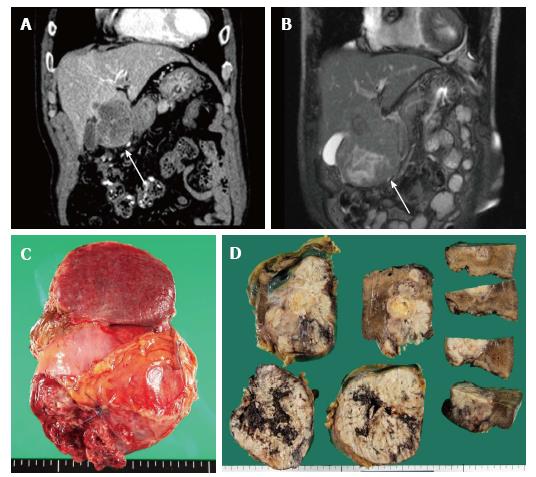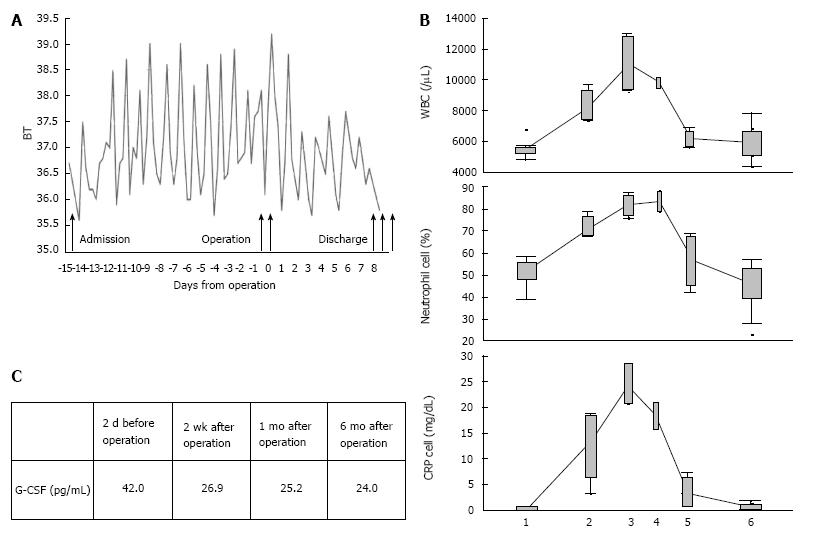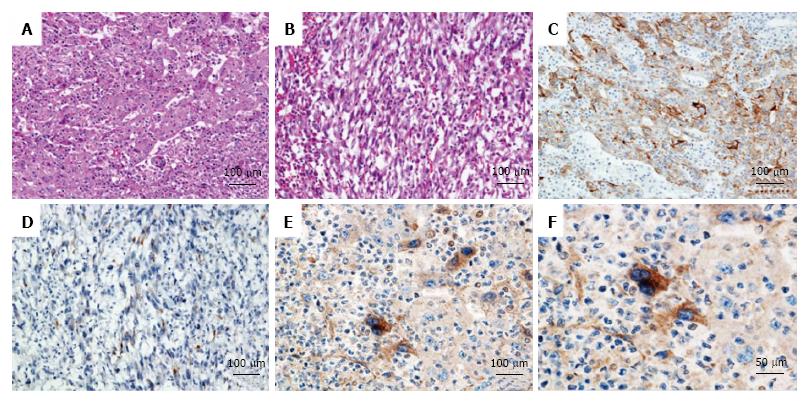Copyright
©The Author(s) 2016.
World J Clin Oncol. Oct 10, 2016; 7(5): 380-386
Published online Oct 10, 2016. doi: 10.5306/wjco.v7.i5.380
Published online Oct 10, 2016. doi: 10.5306/wjco.v7.i5.380
Figure 1 Imaging and macroscopic findings of granulocyte colony-stimulating factor producing hepatocellular carcinoma.
A: CT scan one month before operation showed an irregular liver mass located in segment IV, approximately 60 mm in diameter with peripheral enhancement (white arrow head); B: T2-WI MRI one week before operation showed the rapidly growing liver mass with a 100 mm diameter (white arrow head); C: Macroscopic examination showed a large tumor (100 mm × 100 mm) that protruded through segment IV of the liver to the greater omentum; D: The irregular liver tumor in segment IV showed a central necrosis.
Figure 2 Physiological and laboratory changes during the treatment.
A: Changes in body temperature during the treatment; B: Laboratory changes during the treatment; 1: Steady state; 2: Admission; 3: Pre operation; 4: Post-operation; 5: Within 2 mo after operation; 6: More than 2 mo after operation; C: White blood cell count, neutrophil proportion and C-reactive protein were collected at various treatment points including “steady-state” (more than six months before admission), “before admission” (within six months of admission), “pre-operation” (from admission until operation), “post-operation” (from operation until discharge), “within two months of surgery” and “more than two months after operation”.
Figure 3 Histopathologic findings.
Microscopic findings showed atypical poorly differentiated cells with a sheet structure (A); HCC tumor was also composed of sarcomatous spindle-shaped cells (B); in both samples, a drastic infiltration of the neutrophils was found (H and E, × 20). Immunohistochemical findings showed CAM5.2 positive in the moderately to poorly differentiated HCC lesion (C) and negative in the spindle-shaped cell lesion (D) (CAM5.2, × 20). Immunohistochemical examination showed that G-CSF was positive in the moderately to poorly differentiated HCC lesion (E, F) (G-CSF, × 20 and × 40). G-CSF: Granulocyte colony-stimulating factor; HCC: Hepatocellular carcinoma cell.
- Citation: Nagata H, Komatsu S, Takaki W, Okayama T, Sawabe Y, Ishii M, Kishimoto M, Otsuji E, Konosu H. Granulocyte colony-stimulating factor-producing hepatocellular carcinoma with abrupt changes. World J Clin Oncol 2016; 7(5): 380-386
- URL: https://www.wjgnet.com/2218-4333/full/v7/i5/380.htm
- DOI: https://dx.doi.org/10.5306/wjco.v7.i5.380











